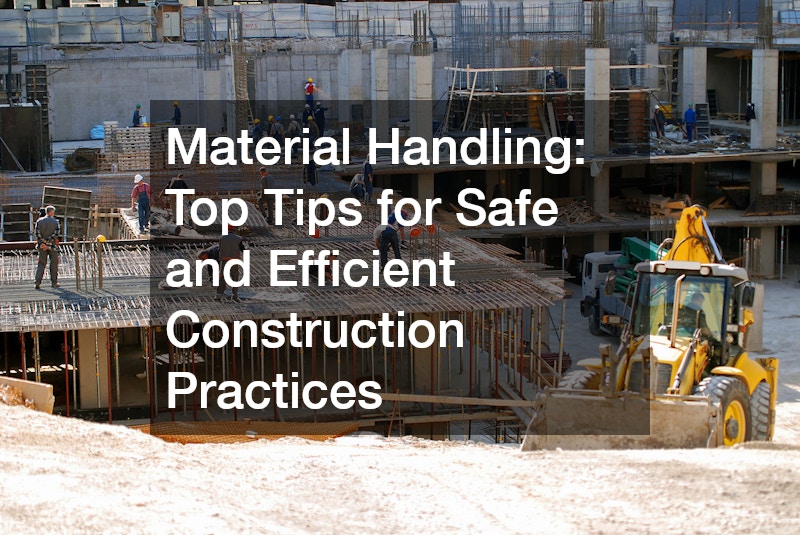Material handling on construction sites involves various tasks, including pushing, pulling, and lifting. Given the heavy and often awkward nature of construction materials, safety and efficiency are of utmost importance. Here are some essential tips to help you handle materials safely and effectively.
Safe Storage Practices
Proper storage is crucial in efficient material handling. Start by planning your storage areas carefully.
Ensure there is sufficient space for forklifts or manual movement of materials. For transporting and storing materials efficiently, consider using cargo aluminum trailers. These trailers offer durability and are resistant to corrosion, making them ideal for transporting heavy and bulky items safely.
A well-organized storage area minimizes the risk of accidents and ensures easy access. Here are some tips to consider:
Avoid Blocking Exits:
Make sure that stored materials do not obstruct exits, such as stairs or doors. This precaution is crucial for maintaining clear evacuation routes in case of emergencies.
Organize and Clean:
Keep storage areas tidy to prevent tripping hazards. Regularly clean and organize materials to ensure a safe working environment.
Adhere to Load Limits:
Do not exceed the maximum load limits of floors and surfaces used for storage. For example, stack bagged materials by offsetting the layers and cross-keying the bags every 10 bags high. Avoid overloading scaffolds, runways, or stacking bricks higher than 7 feet and masonry blocks higher than 6 feet. For lumber, adhere to a maximum height of 20 feet when using mechanical means or 16 feet for manual stacking.
Manual Handling Techniques
Manual lifting is one of the leading causes of workplace injuries. To reduce the risk of strain and other injuries, use proper lifting techniques:
Maintain Proper Posture:
Position yourself close to the load with your feet shoulder-width apart, and place one foot slightly in front of the other for better balance. Bend at your knees, not your waist, to squat down, and keep your back as straight as possible.
Secure Grip:
Before lifting, ensure a firm grasp on the object. As you lift, use your legs to straighten up, avoiding twisting your body during the lift.
Keep Load Close:
Once the lift is complete, keep the load as close to your body as possible. This reduces stress on your lower back, minimizing the risk of injury.
Avoid Awkward Postures:
Refrain from reaching behind, bending forward, or twisting your body while handling materials. Such postures can lead to musculoskeletal strain.
Manage Weather Conditions:
Be mindful of the weather. Cold temperatures can reduce muscle flexibility, while hot temperatures can lead to dehydration and fatigue. Adjust your work practices accordingly to accommodate these conditions.
Efficient Use of Mechanical Equipment
Using mechanical equipment can greatly enhance safety and efficiency on construction sites. Here are some guidelines to follow:
Select Appropriate Equipment:
Use tools such as dollies, hoists, and forklifts to handle heavy or bulky materials. Ensure that the equipment is not overloaded and is used within its rated capacity.
Operator Training:
Only allow trained and qualified personnel to operate forklifts and other machinery. Proper training ensures that equipment is used safely and effectively.
Avoid Overloading:
Do not overload equipment beyond its capacity. Overloading can lead to equipment failure and increased risk of injury.
Additional Safety Tips
Rotate Tasks:
To prevent repetitive strain injuries, rotate tasks among workers. This reduces the risk of overuse injuries and keeps workers engaged.
Store Materials Safely:
Store heavier materials in locations that are easy to access and handle safely. Utilize proper handholds and ensure that containers and materials are designed for safe handling.
Wear PPE:
Always use appropriate personal protective equipment (PPE) to protect against injuries. Proper gloves, helmets, and other safety gear are essential for preventing accidents.
Take Regular Breaks:
Regular breaks are crucial for allowing muscles to rest and recover. Break tasks into shorter segments to prevent fatigue and reduce the risk of injury.
In Closing
By following these tips for safe and efficient material handling, construction sites can operate more smoothly and with fewer accidents. Proper planning, adherence to safety practices, and the use of appropriate equipment all contribute to a safer and more productive work environment. Implementing these practices helps ensure that construction projects are completed efficiently while prioritizing the health and safety of all workers.
.


